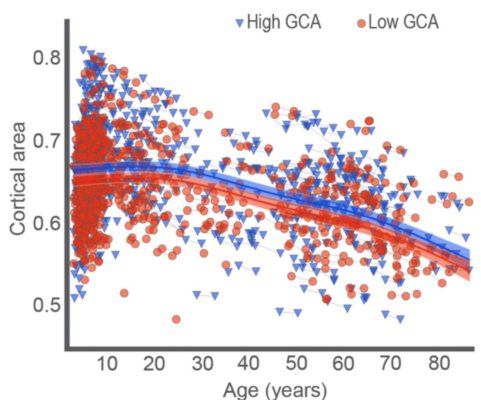Development of white matter microstructure in relation to verbal and visuospatial working memory – A longitudinal study
Krogsrud S. K., Fjell, A. M., Tamnes C. K., Grydeland, H., Due-Tønnesen, P., Bjørnerud, A., Sampaio-Baptista, C., Andersson, J., Johansen-Berg, H. & Walhovd, K. B.
The Temporal Dynamics of Brain Plasticity in Aging
Glasø de Lange, A., Bråthen, A. C., Rohani, D., Fjell, A. M. & Walhovd, K. W.
Poor sleep quality and Alzheimer’s biomarkers
Sleep is associated with many beneficial brain processes, including the strengthening of synaptic connections that correspond to memories and learnt material, and the clearance of potential neurotoxic proteins.
As we get older we have a general tendency to sleep less. Previous work in our lab has demonstrated an important link between self-reported poor sleep quality and accelerated brain atrophy in widespread regions across the cortex, indicating that brain atrophy may be a cause or a consequence of sleep problems as we age.
The accumulation of a peptide known as β-amyloid (Aβ) is perhaps the most established biomarker for Alzheimer’s disease to date, as its occurrence often predates cognitive decline in the ageing brain. Evidence also suggests that Aβ accumulation links with problems sleeping. In a new study, LCBC researchers used measurements of Aβ and other established Alzheimer’s biomarkers taken from the cerebrospinal fluid—the clear liquid encasing the brain and spinal cord—together with measurements of brain atrophy, memory and depression, to test whether these predicted sleep problems in cognitively healthy older adults.
Results indicated that higher levels of a biomarker associated with degeneration in the brains axons, Tau, and a marker associated with neuroinflammation, YKL-40, predicted sleep problems, only in healthy adults with Aβ. Poor sleep quality was also uniquely related to poorer memory functioning, higher depression scores and more extensive brain atrophy.
The findings underscore the importance of understanding the role that sleep plays in age-related brain- and cognitive changes that are associated with pathology and increased risk for Alzheimer’s disease.
Citation
Early life affects how we age – new PNAS paper
Older adults tend to vary considerably when it comes to performance on certain mental tasks; some older individuals perform very well while others perform quite poorly. However, we know that a person’s cognitive performance in later life tends to be somewhat similar across various mental tasks, such that high performance in one cognitive domain tends to accompany high performance in others as well. Older people also vary widely to the extent that they are able to cope with the brain changes that are occurring during the aging process, and to what extent they impact upon behavioural performance. Aging research has therefore inferred that the extent of cognitive decline seen in aging is also determined by factors present before the onset of old age, a concept known as ‘brain reserve’. This concept is backed-up by research showing that people with higher levels of education show equal Alzheimer’s-related brain pathology as lesser-educated people. However, higher education is associated with less cognitive decline despite the presence of equal Alzheimer’s-related brain pathology.
If earlier factors (such as education) can help protect against cognitive decline in aging, then this suggests that in order to truly understand the brain aging process, we need to go further back in time. We at LCBC are among those who take this idea the furthest, arguing that the aging process needs to be considered against the backdrop of the entire lifespan, in which both development and aging are considered as one long, undivided and continual process. With this view, factors apparent very early in life (such as birth weight) should also impact upon brain aging.
In LCBC’s latest paper published in the prestigious scientific journal Proceedings of the National Academy of Sciences of the United States of America, the authors tested whether brain measurements that relate to one’s general cognitive ability (GCA) during development (i.e. at less than 12 years of age) could predict later changes in GCA from in later life, and whether early life factors could predict the life trajectory of brain-cognition relationships.
It was found that cognitive ability during development was associated with cortical area across much of the brain, lending support to the idea that general mental performance is made possible by the coordination of large-scale brain networks. Later brain changes for children scoring higher in GCA were then tested against those for lower-scoring children, revealing a parallel change trajectory for both groups (below figure). This suggests that early life factors may exhibit a continued influence on later brain changes. Further analyses revealed that one’s birth weight and the education level of one’s parents also predicts the trajectory of brain-cognition measurements occurring later in life.
In sum, the paper shows that the relationship between brain measurements and cognitive scores appears to be remarkably stable throughout life, and that factors apparent from birth impact upon the aging process.

Citation
99. Neurodevelopmental origins of lifespan changes in brain and cognition ![]()
Proceedings of the National Academy of Sciences of the United States of America
Walhovd, K. B., Krogsrud, S. K., Amlien, I. K., Bartsch, H., Bjørnerud, A., Due-Tønnessen, P., … & Fjell, A. (2016)
